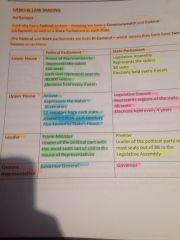![]()
![]()
![]()
Use LEFT and RIGHT arrow keys to navigate between flashcards;
Use UP and DOWN arrow keys to flip the card;
H to show hint;
A reads text to speech;
8 Cards in this Set
- Front
- Back
|
Outline 2 differences & 2 similarities between legal and non legal rules.
|
A rule is made to apply to a specific group; for example a teacher and principal make rules for a school which only apply to students in that school whereas a legal rule (law) is made by parliament which applies to everyone in Australia and a state law applies to everyone in that state.
Another difference is the consequence for breaking a rule are often small, while the consequence for breaking a law can be very serious eg imprisonment. |
|
|
Provide an example of a legal and non legal rule. Explain what the likely consequence would be for each.
|
LEGAL RULE (law)
Speeding : monetary penalty (fine.) NON LEGAL RULE Not following teachers instruction : detention. |
|
|
Explain why it is important for laws to be accepted by the community.
|
A characteristic of an effective law is that it is accepted by the community so, It is important for laws to be accepted by the community because if they aren't no one will follow the law and will disobey the law.
|
|
|
Identify the characteristics of an effective law.
|
The characteristics of an effective law are that it is know and understood by the community, that it reflects values and is accepted by the community and it adapts to change.
|
|
|
Outline the ways in which laws can be made in Australia.
|
Laws can be made by subordinate authority; different groups make different laws accustomed to specific groups and parliamentary legislation; made by the government.
|
|
|
Outline the details surrounding the snail in the bottle case and explain the significance the case has in legal history.
|
The snail in the bottle case is about Donohugh finding a snail in the bottom of her drink, and sued Stevenson (the owner of the brand of ginger beer.)
This is significant in legal history because it established the neighbour principal in negligence ; duty of care to all who are reasonably affected by your actions. |
|
|
Legislative process.
|
-First step is being drafted by the parliamentary council,
-Second step is the 1st reading in the lower house, -Third step is the 2nd reading in the Lower house and the consideration, -Fourth step is the 3rd reading and vote in the lower house -fifth step is the 1st reading in the upper house -sixth step is the 2nd reading and consideration in the upper house - seventh step is the 3rd reading and vote in the upper house -eighth step and only if all else goes to plan , the Governor General/governor signs the bill. |
|
|
Outline the structure of State and Federal Parliament.
|

|

